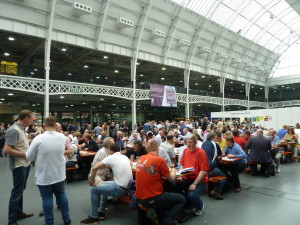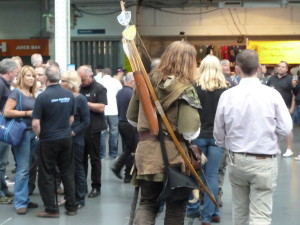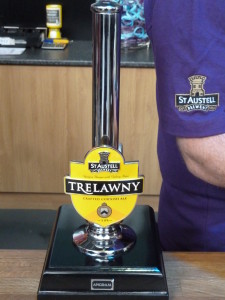Ed Note: Inevitably, marching into another country and talking about a situation I don’t have a complete feel for has the potential to rustle feathers. As such, I have changed the subtitle of my blog for the week to reflect that possibility.
One of the things that has interested me about England recently is the speed with which craft beer has taken off. I was here last in 2008, before I had started paying proper attention to things beery. At the time, I think that I was mildly aware that Meantime existed, but I certainly didn’t go out of my way to visit them. There was a very nice pub with cask beer in good condition nearby where I was staying which was good enough for me. What did I know?
I’m not sure how many of the English beer writers I now know were active at the beginning of 2008. I suspect that the answer is not all that many. At some point while planning for this trip, I emailed Mark Dredge and Pete Brown for suggestions about where I needed to go and what I needed to see. The list very quickly became elaborate and almost completely untenable. Brodies and Camden Town, Magic Rock and Kernel and Partizan and Brew Wharf. That was just the first email. The number of craft beers on offer has continued to expand.
Within about five years there has been this massive explosion of non-traditional, North American influenced breweries. I’m given to understand that this is happening all over Europe. Just the other day, I had a couple of Czech craft beers from Pivovar Matuska that were using Apollo and Galaxy hops. I can only imagine the stir that’s causing in Prague.
To me, the most interesting part of this phenomenon is that England is one of the only countries other than the United States that has a definitive sensibility for the marketing of their product. They’ve got REAL ALE.
CAMRA’s definition of REAL ALE is, even according to their materials, something that they’ve made up. According to my handy CAMRA membership guide fact sheets, Real Ale is “a term devised solely by CAMRA” as “a name for draught (or bottled) beer brewed from traditional ingredients, matured by secondary fermentation in the container from which it is dispensed and served without the use of extraneous gas.”
Ok. That makes a great deal of sense since there was a real danger of traditional English ale being supplanted by incredibly bad lager and terrible ale in the 1970’s. All you have to do for context is listen to the utter disdain in Eric Idle’s voice when he talks about Watney’s Red Barrel in the travel agent sketch.
If you can control the perception of what entails a quality beer, you’d be a fool not to do it. From a marketing standpoint it’s brilliant. It plays to a sense of patriotism. It plays to the sense that it has always been thus. Most importantly, those trappings are not actually part of the definition. Real Ale is a technical term. It just has all these connotations associated with it.
Look at the definition of craft beer. If the last year worth of debate on North American blogs has taught us anything, it’s that the definition doesn’t really work properly. It is not a technical, product oriented definition. It’s a trade designation at best and a vague catchall at worst.
The Brewer’s Association basically has three conditions as far as I’m aware. I’m writing this on a train to Birmingham New Street, so I’m listing these from memory. The fact that I do not care enough to ingrain them perfectly in my memory is probably a sign of how poor they are.
1) The brewer must produce less than 6 million barrels of beer a year.
2) The brewer must not use adjunct (at least as a money saving ingredient, I guess)
3) The brewer must be mostly independently owned. (No more than 25% owned by a larger company)
Perhaps you begin to see the problem with the definition when you try to apply it on an international scale. Craft beer is no longer a purely North American phenomenon. Those rules are nonsensical even across the border in Canada. Our economy is on an entirely different scale and we actually like some of the brands Molson has purchased.
When you’re talking about England, those conditions are even less useful. Because “Craft Beer” as a nomenclature exists to describe a purely American phenomenon, it neglects to include anything about heritage.
Take just about any large, regional English brewery. Anything smaller than Greene King will do as an example. They are small, traditional and independent. Some of them are so traditional that they predate the concept of trademarks. More than two hundred years and suddenly there’s a new definition of what you do, thanks to a trade description that has become a catchall term for a global phenomenon.
CAMRA, perhaps unfortunately, has gone the route of attempting to define craft beer as anything that’s served out of a keg. That’s an attempt to lump the craft brewers in with the lagers that have been their bane since the early 1970’s. That’s a terrible idea for two reasons: First of all, lager is not going away. Whatever inroads CAMRA has made into preserving real ale is great and entirely worthwhile. It’s not all support for their side, of course. The number of British Ex-pats I’ve heard refer to anything out of a keg as weasel piss is pretty staggering. Any time people attempt to generalize about an entire category of beer, I’m leery. Some lagers are good, some lagers are bad. Some Real Ales are shockingly poor on their best day with a good cellarman.
The other problem is that it creates a fairly significant demographic gap. From the perspective of an outsider with no real stake in what happens, I can freely point out that I keep hearing Real Ale being referred to as Old Man’s Beer. The comment crops up again and again on blogs and discussion boards, on untappd and on facebook statuses detailing which beer won at the Great British Beer Festival. Given the crowd at the trade session and the sheer number of sock/sandal combinations on view, I can see how people might be justified in the opinion. (I’m given to understand that the trade session is not representative of the demographic. Part of me wants to believe that. Part of me thinks “sure it isn’t.”)
The question becomes: how does a brewery stay relevant in the face of this divide?
The truth is that many of the Real Ales are excellent beers. These are breweries that have honed their craft for a very long time and they produce some excellent tipples. Since craft beer isn’t going away any time soon and the younger generation of beer drinkers seems to be hoving round in that direction, these breweries are entering a landscape fraught with pitfalls. Do you sacrifice some of your hard earned, long standing credibility in order to maintain or increase sales by capitulating to a trend? Do you put your head in the sand and hope it goes away despite all evidence to the contrary?
There were, I noticed, two large regional breweries attempting to do something about it and their wares were displayed at the GBBF.
Brains is based out of Cardiff. Their foray into craft brewing is based out of a separate 15BBL brewhouse in the same facility as their regular brewery if I understand it correctly. Rather than the properly stylized BRAINS logo, they’ve gone with a sort of riveted font that playfully suggests an industrial heritage, harkening back to the era in which they were founded (1882). This means that they’re playing both sides of the aisle, retaining their popular main portfolio in addition to the new brands. Even the websites are divided between the original and the extra crispy.

Brains brought a bacon beer. I imagine it’s only a matter of time before they try making a beer with brains. Zombibrau.
The main portfolio has things like Dark, Gold and The Rev. James. These are pretty highly regarded beers and rightly so. I’d be pleased to find any of them on tap. They may not be the most exciting beers in the world, but they’re solid and dependable. If you ignore the substance of my argument thus far and don’t bother attempting to categorize them, you’d come away with the feeling that they’re good, solid beer.
The new stuff… well, let me put it this way. I tried three of the casks that were on offer at the GBBF and the sense I get is that they’re trying way to hard. They’ve enlisted beer writers like Adrian Tierney-Jones and Pete Brown to collaborate with them on various products. They’ve got single hop variations and the odd wacky ingredient. I tried the Aporkalypse (which was, as far as I’m concerned, the final straw on bacon flavoured beer. The next person who sends one of those for review is going to get a stern staring at and a slow, disapproving head shake), Dissolution and Atlantic White. Certainly, they’re different than anything else that was on offer at the festival, but the real problem is that they don’t stack up to “craft beer.” If I got these in Ontario, which is a little behind the times, they wouldn’t stand out.
If Brains can reign in the experimentation a tad, they’re onto a winning concept. The experimentation is unnecessarily probing. I’m sure they’ve got talented people who would do better to focus on a core range.
The brewery I was far and away the most impressed with is Cornwall’s St. Austell. Rather than putting together a second brand, they seem to have decided to simply play to their strengths. This is a brewery that has been around since 1851, but the sense I get is that they’ve taken a longer view of the craft beer problem. Their Tribute Ale was first brewed in 1999 and it feels somehow contemporary nearly 15 years later.
St. Austell has simply expanded on the success of Tribute by keeping the ingredients contemporary rather than attempting to do anything outlandish. Their Trelawny is a combination of old and new, blending English Golding with Australian Galaxy hops. You get peach, apricot, and the strange slightly ineffable tropical fruit note you get with Galaxy. At 3.8%, this is session beer at its best.
Their Proper Job incorporates Willamette, Chinook and Cascade at 4.5% and is a really nicely balanced low alcohol (by craft standards)IPA. The top of their range is Big Job, which I enjoyed so much that I didn’t bother to ask for the ingredients. I will say this for it: It would be acceptable as ‘craft beer’ anywhere in the world and hasn’t compromised the ‘real ale’ definition at all.
St. Austell is doing all of the things I like. They’re taking advantage of history. They’re using a blend of traditional ingredients and exciting new ingredients. There is a sense of evolution if you look at the timeline on which these products have been introduced. They are clever enough to be just ahead of the market.
That’s how you navigate the Real Ale/Craft Beer minefield: You ignore the definitions completely and you focus on making good beer. Not everyone will be able to toe that line with the level of success that St. Austell displays, but it’s apparent to me that you can accomplish both definitions at the same time.





Excellent post, and good to see the love for St Austell. As far as we can tell, Tribute was entirely the doing of the Head Brewer (Roger Ryman) and the board took some persuading before deciding to add it to the main range. The Celtic beer festival in St Austell in the autumn is a showcase for his innovation and the one chance those of us living in Cornwall get to try the more “craft” offerings (most disappear to the Craft Beer bars of London and the north)
“CAMRA, perhaps unfortunately, has gone the route of attempting to define craft beer as anything that’s served out of a keg.”
I’m not convinced they have, actually. Some of their members may have done so in some of their material, but on the other hand our local CAMRA beer festival programme had a “what is craft beer” bit that basically said “craft beer isn’t particularly well defined, but craft beer can be real ale if its on cask and we’ve got some craft beers on cask for you to try at this festival.” As far as I can tell they organize most things on a principle of “find someone to do it and then leave them to get on with it” and don’t have a rigorously enforced party line on anything but their biggest campaigning issues.
And it seems a bit odd for you to flag the “craft = keg” definition and the craft vs real ale dichotomy as problematic (rightly, IMO, as it leads to stupid ideas like Thornbridge being a craft bewery when they sell kegged stuff but not when they sell cask) but then accept it a couple of paragraphs later when you talk about “the divide.”
Interesting stuff about Brains and St Austell, though, and it’s heartening to see bigger brewers taking an interest in some of the good ideas that the craft scene is helping to popularize.
From what I can see, Americans brought two things to the table that have influenced the British in similar ways:
1) new hop flavours, and later non-hop flavourings; and
2) a higher quality draft keg beer than the British were accustomed to. In canned and bottled form England always had this, e.g., rich beers like Ruddles County, various barley wines, Old Peculier, etc. The Americans made something similar but initially at moderate gravities and serving unpasteurized on draft. (But e.g. Whitbread Gold Label, at least at the beginning, was not pasteurized either, it was centrifuged).
Except for the lager and wheat beer side of the equation (later sour beers), all the inspiration was U.K. But as often happens, a variation emerged and now the Brits are inspired in turn, thus the single-hop beers using American and other New World varieties, bacon beers, etc.
So it all intertwines and develops together but the one thing that stands out as different and superior when done properly is the cask process. CAMRA would lose its distinctiveness and perhaps raison d’etre if it dropped that criterion and they are right IMO to keep things as they are. So far from what I hear the festivals are well-attended and successful…
Gary
Nice to see someone else thinks that official Brewers Association definition of craft beer is stupid. I mean how can you have a definition of craft anything that doesn’t have some sort of requirement for quality and craftsmanship. I mean small/traditional/independent is nice I guess but where is “good” in that list of requirements?